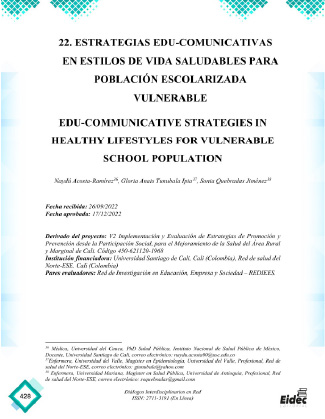XXII. EDU-COMMUNICATION STRATEGIES IN HEALTHY LIFESTYLES FOR SCHOOL POPULATION VULNERABLE
##plugins.themes.bootstrap3.article.main##
Abstract
Justification: Adolescents experience rapid changes due to processes of
physical, sexual and emotional maturation. From a public health perspective, it is considered
that these age groups are highly socially vulnerable due to risk behaviors that
they can assume. Objective: Characterize health risks and develop educommunication strategies on priority issues to face them, in the adolescent population
schooled in the northern zone of the municipality of Cali. Methodology: intervention projects
developed in partnership between the Santiago de Cali University (USC) and the Red de Salud
del Norte ESE in the first semester of 2022. The school population subject to intervention
were students of the INEM Educational Institution of Cali, involving in the development
of the project to students of community medicine practice at USC. Results:
Through consensus, nine themes are established (Alcoholism/cocktails,
Smoking / Vaping, Addiction to social networks, Bullying, Addiction to SPA and Clonacepan,
Resilience and conflict resolution, Life Project, sexual and reproductive rights).
Through the Ocaret strategy, strategies are proposed to promote habits
healthy, which are developed through conferences, conversations, videos and brochures.
Conclusions: multiple benefits since it contributes to the promotion of lifestyles and
healthy behaviors in vulnerable population; and at the same time it gets involved and approaches the
university academic community with its social environment, contributing to the formation of
future professionals with skills with academic and humanistic quality.
Download Statistics
##plugins.themes.bootstrap3.article.details##
Adolescents, Self-care, Health Education, Promotion of health, Health Risks.
COMPETENCIAS EN EDUCACIÓN SUPERIOR: ¿USO O ABUSO?. Profesorado.
Revista de Currículum y Formación de Profesorado, 19(2),265-280.[fecha de
Consulta 5 de Septiembre de 2022]. ISSN: 1138-414X. Disponible en:
https://www.redalyc.org/articulo.oa?id=56741181017.
Del Canto, Ero, y Silva Silva, Alicia (2013). Metodología cuantitativa: abordaje desde la
complementariedad en ciencias sociales. Revista de Ciencias Sociales (Cr), III (141),
pp. 25-34.
Gutiérrez, A. & Ferreira, W. (2020). Un modelo de regresión lineal aplicando lógica difusa.
Revista Sextante, 23, pp. 48 - 54, 2020.
Hernández, R., Fernández, C., y Baptista, M. (2010). Metodología de la investigación (5th
ed.). México D.F.: McGRAW-HILL.
Jamsandekar, S., y Mudholkar, R. (2013). Performance Evaluation by Fuzzy Inference
Technique. International Journal Of Soft Computing And Engineering, 3(2), pp. 158-
164.
Martínez, J. (2008). Las rúbricas en la evaluación escolar: su construcción y uso. Avances en
Medición, 6, 129-138.
Monje, C. (2011). Metodología de la investigación cuantitativa y cualitativa. Guía didáctica.
Neiva: Universidad sur colombiana.
Picón Jácome, Édgar (2013). La rúbrica y la justicia en la evaluación. Íkala, revista de
lenguaje y cultura, 18(3),79-94.[fecha de Consulta 5 de Septiembre de 2022]. ISSN:
0123-3432. Disponible en: https://www.redalyc.org/articulo.oa?id=255030038006.
Sánchez García, J. E. ., Valdez Sandoval, A. ., Soto Vega, J. E. ., & Gutiérrez Herrera, B. E.
. (2021). Comparación del nivel de desempeño de una competencia usando tres
instrumentos, dos basados en rúbrica y otro basado en lógica difusa: A comparison of
the level of competency using three instruments; two rubric based instruments and a
fussy logic-based instrument. Revista Relep - Educación Y Pedagogía En
Latinoamérica, 2(4), 123–145. https://doi.org/10.46990/relep.2020.2.4.245.





